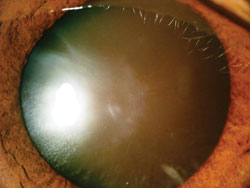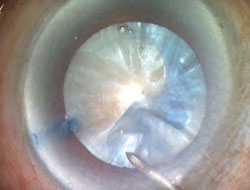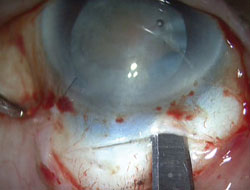Do manual non-phaco techniques have a place in cataract surgery?
Although phacoemulsification has many advantages, some cases may instead call for manual small-incision cataract surgery or extracapsular cataract extraction.
 Amar Agarwal |
Of all the surgeries in ophthalmology, cataract surgery is one of the most popular and successful. With smaller incisions, no sutures, topical anesthesia and clearer uncorrected vision, phacoemulsification has become the preferred method of cataract extraction. But the speed at which advances are taking place in this field often leaves one emerging from one learning curve only to face another.
The pertinent question now is: Is extracapsular cataract extraction (ECCE) still relevant? In other words, is phaco preferable in all cases for all surgeons? Should one learn manual non-phaco techniques such as manual small-incision cataract surgery?
Brunescent and black cataracts
In a black cataract (Figure 1), the use of excessive ultrasound energy, prolonged surgical time, increased stress on the bag-zonular complex and greater endothelial damage may lead to a dismal first-day postop outcome, which may result in a longer recovery. Manual small-incision cataract surgery (SICS) and ECCE, on the other hand, generally provide very good anatomical results even in brown cataracts. Cracking and chopping are both difficult to accomplish in brown cataracts and are often incomplete. Repeated unsuccessful attempts at chopping in the bag could cause stress on the bag-zonular complex and result in the disastrous complication of nucleus drop.
Morgagnian cataracts
Morgagnian cataracts are hypermature cataracts with weak zonules. The mobile, lax anterior capsule makes rhexis a challenge in these eyes. The hyperdense, shrunken nucleus is also very mobile, increasing the chances of endothelial damage. The lack of a protective epinuclear and cortical shell increases the risk of a posterior capsule rupture and nucleus drop during phacoemulsification. Weak zonules could also result in zonular dialysis.
 Figure 1. Black cataract. |
 Figure 2. Rhexis running away in a hard brown cataract. Images: Agarwal A |
 Figure 3. Conversion to manual non-phaco technique (small-incision cataract surgery). Note the temporal clear corneal incision is sutured. The conjunctiva is cut, cautery done and a scleral tunnel incision made. |
 Figure 4. The nucleus is delivered manually. Then cortical aspiration is done, and the IOL of the surgeon’s choice implanted. |
Severe pseudoexfoliation
Severe pseudoexfoliation is associated with preoperative challenges such as a poorly dilating pupil, posterior synechiae, shallow anterior chambers, hard cataracts, weak zonules, phacodonesis and subluxated cataracts, all of which can increase the risks of phacoemulsification.
Zonular dialysis, weakness
With phaco, excessive traction on the capsule during rhexis can enlarge the zonular dialysis, as can nucleus rotation as well as chopping and cracking maneuvers. Difficult surgery results in capsular or zonular tears and vitreous loss, and this is a situation in which surgical experience becomes a crucial factor. Performing an ECCE in such eyes, although also associated with a greater risk of intraoperative complications, is still safer than phacoemulsification in novice or inexperienced hands.
Eyes with shallow anterior chambers
Shallow anterior chambers make intraocular maneuvering difficult and increase the risk of endothelial contact and phaco energy-related endothelial damage. These eyes also present increased risk of surge and Descemet’s detachment.
Small pupil with hard cataract
Even with the help of a pupil expander, working with small pupils can still be challenging, especially in cases of black cataract. The phaco tip may cause further damage to the pupil.
Phacolytic glaucoma
Phaco is not a viable option in eyes with phacolytic glaucoma because of weak zonules and corneal edema, which hampers visualization.
Bad endothelial count
In eyes with cornea guttata or dystrophies, phacoemulsification may tip the scales of an already borderline endothelium, especially if the nucleus is hard or the anterior chamber is shallow, resulting in pseudophakic bullous keratopathy.
Conversion from phaco
A die-hard phaco surgeon may need to be familiar with converting to ECCE (Figures 2 to 4), especially in case of complications such as a lengthening phaco time, high phaco energy levels, zonular dialysis, posterior capsular rent or vitreous loss.
ECCE can be done using a can-opener or envelope capsulotomy, the latter being preferable because three-quarters of the capsule is left intact until after IOL implantation, providing sulcus support in case of posterior capsular rent. Controlled pressure-counter pressure allows safe and easy delivery of the nucleus. Applying two sutures before cortex aspiration gives a virtually closed chamber, increasing the safety of the procedure.
Manual SICS combines many of the advantages of ECCE as well as phaco. It is good for tackling tough cases, such as brown cataracts, and is also sutureless and induces less astigmatism.
Conclusion
With an experienced surgeon, phacoemulsification may be possible in all cataract types, but it is important to remember that the chances of complications with phaco are higher in the hands of someone who does not regularly perform such surgeries. Also, there are often instances in which it is advisable to enlarge the phaco incision and convert to an ECCE. Hence, ECCE and manual SICS or other non-phaco manual techniques are a very safe and useful alternative and should be in every cataract surgeon’s armamentarium.
As both ECCE and phaco have their own limitations, the ideal technique would be one that combines the best of both worlds. With the femtosecond laser coming into its own, femtosecond cataract surgery may evolve to combine the precision, predictability and safety of lasers with surgeon programmability, and this may indeed prove to be the holy grail for all cataract surgeons. But until then, we believe ECCE is still alive.

- Amar Agarwal, MS, FRCS, FRCOphth, is director of Dr. Agarwal’s Eye Hospital and Eye Research Centre. Prof. Agarwal is the author of several books published by SLACK Incorporated, publisher of Ocular Surgery News, including Phaco Nightmares: Conquering Cataract Catastrophes, Bimanual Phaco: Mastering the Phakonit/MICS Technique, Dry Eye: A Practical Guide to Ocular Surface Disorders and Stem Cell Surgery and Presbyopia: A Surgical Textbook. He can be reached at 19 Cathedral Road, Chennai 600 086, India; fax: 91-44-28115871; e-mail: dragarwal@vsnl.com; website: www.dragarwal.com.









